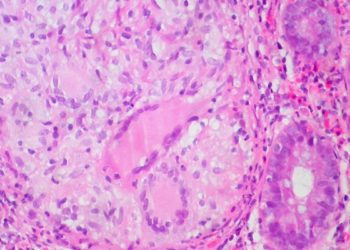Imaging biomarkers may improve prediction of aortic valve stenosis
Image: PD
1. Poor longitudinal function and hemodynamics predicted an increased risk of mortality.
2. Aortic valve replacement is likely to improve survival in those with stenosis.
Evidence Rating Level: 3 (Average)
Study Rundown: Aortic valve stenosis may be optimally treated with aortic valve replacement (AVR) or transcatheter valve implantation (TAVI). It is crucial, however, for patients to understand their prognosis prior to opting for either of these procedures. This study followed 157 patients with aortic stenosis, who initially refused surgical intervention, for an average of 2.6 years. Using transthoracic echocardiography, the investigators measured multiple parameters. The results demonstrated that poor longitudinal function and hemodynamics predicted an increased rate of mortality. Additionally, ejection fraction and EuroSCORE did not accurately predict prognosis. The results also suggested that AVR is likely to significantly reduce mortality in patients with aortic valve stenosis. As surgical treatment of aortic stenosis is becoming more routine, this investigation of patients who refuse surgical intervention provided unique insights into the natural course of the disease and the biomarkers that predict its trajectory.
Click to read the study in The American Journal of Cardiology
Relevant Reading: Decision-making and outcomes in severe symptomatic aortic stenosis
In-Depth [retrospective cohort]: This study observed the clinical course of 157 patients with aortic valve stenosis. Out of the total sample, 62 patients elected to receive aortic valve replacement, while the rest opted for a non-operative approach. The primary endpoints of the study were cardiac mortality and mortality by all other causes. Of those patients who received AVR, 87% survived the follow-up period. In contrast, only 40% of the patients who chose a non-surgical approach survived. NYHA functional class, valvuloarterial impedance, stroke volume, longitudinal strain and strain rate, and mitral annular displacement all predicted an increased risk of mortality (p < .001). Ejection fraction and EuroSCORE did not (EF, p = 0.25; EuroSCORE, p = 0.64).
By Amir Tarsha and Allen Ho
More from this author: Local excision inferior to major resection inT1-2 colon cancer and T2 rectal cancer, Secondary mastoid obliteration improves quality of life for patients with chronic otitis media, Healthcare reform linked with reduced racial disparities in surgical care, VATS lobectomy may be preferred in COPD with non-small-cell lung cancer, One-on-one training leads to improved virtual reality laparoscopic performance, Stem cell enrichment of fat grafts ineffective in breast augmentation
©2012-2013 2minutemedicine.com. All rights reserved. No works may be reproduced without expressed written consent from 2minutemedicine.com. Disclaimer: We present factual information directly from peer reviewed medical journals. No post should be construed as medical advice and is not intended as such by the authors, editors, staff or by 2minutemedicine.com. PLEASE SEE A HEALTHCARE PROVIDER IN YOUR AREA IF YOU SEEK MEDICAL ADVICE OF ANY SORT.







